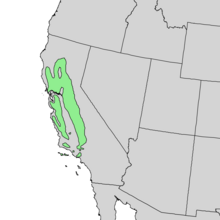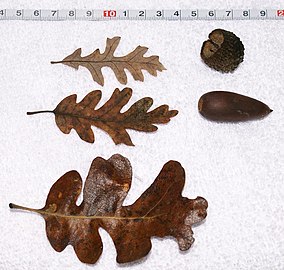Quercus lobata
| Quercus lobata | |
|---|---|

| |
| Valley Oak near Mount Diablo, with mistletoe | |
| Scientific classification | |
| Kingdom: | Plantae |
| Clade: | Tracheophytes |
| Clade: | Angiosperms |
| Clade: | Eudicots |
| Clade: | Rosids |
| Order: | Fagales |
| Family: | Fagaceae |
| Genus: | Quercus |
| Subgenus: | Quercus subg. Quercus |
| Section: | Quercus sect. Quercus
|
| Species: | Q. lobata
|
| Binomial name | |
| Quercus lobata | |

| |
| Natural range of Quercus lobata | |
| Synonyms[3] | |
|
List
| |
Quercus lobata, commonly called the valley oak or roble, is the largest of the
Description
The valley oak may surpass 30 meters (98 feet) in height, with a sturdy trunk possibly exceeding 3 m (10 ft) in diameter. The "Henley Oak", in Covelo, California, is the tallest known valley oak, at 47 m (153 ft).[7][8]
The branches have an irregular, spreading and arching appearance. During autumn, the
Typically, the leaves are 5–10 centimeters (2–4 inches) long and are roundly and deeply lobed. The leaf width is approximately one half its length. Each leaf is matte green with an underneath pale green appearance; moreover, the leaf is covered with abundant soft fuzz, yielding an almost velvety feeling. When a fresh leaf is rubbed or broken, an
The acorns are medium to dark brown and range from 2 to 3 cm (3⁄4 to 1+1⁄4 in) in length. The caps have deep stippling and are found most often as singlets, but occasionally as doublets. The acorns ripen from October to November.[10] Viable acorns germinate in their first winter, and none remain by mid-winter.
-
Trunk fork and bark
-
Acorn and leaves
-
Mature valley oak on a hillside
-
Leaves
-
Leaves with spined turbaned gall wasp
Taxonomy
Valley oak is of the
The Concow tribe call the acorns lō-ē’ (Konkow language).[11]
Distribution and habitat
Valley oak tolerates cool wet winters and hot dry summers, but requires abundant water. It is most abundant in rich deep soils of valley floors below 600 meters (2000 feet) in elevation. Valley oak is found in dense
The valley oak is widely distributed in: the California
Ecology
Like many oaks, valley oaks can tolerate wildfires. Although smaller individuals may be top-killed, most resprout from the root crown.[13]
A variety of mammals and birds eat the acorns, including the acorn woodpecker, California scrub jay, yellow-billed magpie, and California ground squirrel.[10] The acorns are also attacked by bruchid beetles, but can survive moderate levels of infestation.[14]
Globular
Uses
The acorns are sweet and edible; Native Americans including the Southern Paiute people roasted them and ground the edible portion into meal to make into bread and mush.[15][16]
Difficulties in acquiring valley oak wood as well as issues stemming from its drying such as cracking and warping have shifted its consumption from a general purpose lumber to a primarily niche product.
Observational history

In 1792, the English explorer George Vancouver noted on his expedition through the Santa Clara Valley, after seeing an expanse of valley oaks:
For about twenty miles it could only be compared to a park which had originally been closely planted with the true old English oak; the underwood, that had probably attended its early growth, had the appearance of having been cleared away and left the stately lords of the forest in complete possession of the soil which was covered with luxuriant foliage.[17]
In the year 1861,
First I passed through a wild canyon, then over hills covered with oats, with here and there trees—oaks and pines. Some of these oaks were noble ones indeed. How I wish one stood in our yard at home....I measured one [valley oak] with wide spreading and cragged branches, that was 26.5 feet in circumference. Another had a diameter of over six feet, and the branches spread over 75 feet each way. I lay beneath its shade a little while before going on.[17]
The Hooker Oak of Chico, California, was once considered the largest-known valley oak. When it fell on May 1, 1977, it was nearly 30 m (100 ft) and 8.8 m (29 ft) in circumference at 2.4 m (8 ft) from the ground.
See also
References
- . Retrieved 12 November 2021.
- ^ Née, Luis (1801). Anales de Ciencias Naturales. Vol. 3. p. 277–278: diagnosis in Latin, description in Spanish.
{{cite book}}: CS1 maint: postscript (link) - ^ "Quercus lobata". World Checklist of Selected Plant Families. Royal Botanic Gardens, Kew – via The Plant List. Note that this website has been superseded by World Flora Online
- ^ a b "Quercus lobata". Calflora. Berkeley, California: The Calflora Database.
- ISBN 978-0-9628505-1-6.
- ^ Sawyer, John O; Keeler-Wolf, Todd (1995). A manual of California Vegetation. California Native Plant Society. p. 312.
- ^ "American Forests". americanforests.org. Archived from the original on 2015-12-22. Retrieved 2015-12-21.
- ^ "Towering tree on Fetzer ranch has inspired awe for centuries". Retrieved 2015-12-21.
- ^ a b Nixon, Kevin C. (1997). "Quercus lobata". In Flora of North America Editorial Committee (ed.). Flora of North America North of Mexico (FNA). Vol. 3. New York and Oxford: Oxford University Press – via eFloras.org, Missouri Botanical Garden, St. Louis, MO & Harvard University Herbaria, Cambridge, MA.
- ^ a b c d e f g Howard, Janet L. (1992). "Quercus lobata". Fire Effects Information System (FEIS). US Department of Agriculture (USDA), Forest Service (USFS), Rocky Mountain Research Station, Fire Sciences Laboratory. Retrieved 7 September 2014.
- Government Printing Office. p. 406. Retrieved 24 August 2012.
- ^ a b Griffin, JR; Critchfield, WB (1972). The Distribution of Forest Trees in California. Berkeley: Pacific Southwest Forest Station and Range Experiment Station, United States Department of Agriculture.
- S2CID 13059876.
- S2CID 88931543.
- ISBN 0394507614.
- OCLC 799792.
- ^ a b Balls, EK (1972). Early Uses of California Plants. University of California Press, Berkeley.
External links
- Jepson Manual treatment
- Quercus lobata in the CalPhotos photo database, University of California, Berkeley






